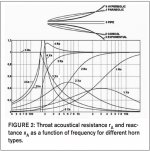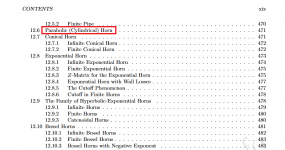But don't look down your nose at analytical approaches to the problem. As I said, as yet, the numerical ones have not come up with any real revelations. Do they predict or can they track HOMs? Not really, so that's a serious limitation. I don;t think that BEM can do transient analysis (not my expertise) but that approach may be able to sort out the HOMs. FEA could certainly do it with a great deal of difficulty.
Earl, I'm just a layman when in comes to acoustics, analytical or FEA approach. It only happend to by my hobby. I have no aspiration to achieve any mastery - I simply don't have the background necessary, and I much admire anyone's analytical skills. If I have some background, it is the maths but I've forgotten much of it already. I actually start focusing on the garden, there's not much to forget about... when you remeber where you leave things.But don't look down your nose at analytical approaches to the problem. As I said, as yet, the numerical ones have not come up with any real revelations. Do they predict or can they track HOMs? Not really, so that's a serious limitation. I don;t think that BEM can do transient analysis (not my expertise) but that approach may be able to sort out the HOMs. FEA could certainly do it with a great deal of difficulty.
What's the use of a parabolic mid/high horn at home?
I know of no useful applications as a waveguide. A parabolic reflector sure, but that was not was presented. A parabolic waveguide would be a disaster from a directivity point of view.
Mabat - understood, no problem. I just like to keep the details straight.
Wouldn't a deviation from spherical wave somewhere down the device be an indication of HOM? This could be observed in BEM analysis. If the simulated horn could be terminated with the right impedance (absorbent cap?), that would separate the contour-related HOMs from mouth diffraction and reflection. Or not?As I said, as yet, the numerical ones have not come up with any real revelations. Do they predict or can they track HOMs? Not really, so that's a serious limitation. I don;t think that BEM can do transient analysis (not my expertise) but that approach may be able to sort out the HOMs.
Yeah, but it has nothing to do with a parabola being the contour of the horn
I never said that it did 🙂. A parabolic horn is defined as one that has a linear increase in cross-sectional area as a function of distance along the axis. It does not necessarily have to look like a parabolic curve.
The parabolic horn is also sometimes called a cylindrical horn in the literature.
Attachments
It is all clear to me. I only didn't get why would you come up with this in the middle of debate concerning a parabolic surface (not) approaching a cylinder. Like if it was something relevant.
But enough of this parabola nonsense 🙂
But enough of this parabola nonsense 🙂
Last edited:
Hi Ro808. As you seem to know everything about (horn-)speaker, I wonder if you can tell me a few details about Strauss SE-MF-2, which is a reference monitor and wouldnt be wrong at all in this thread. A few Pros claim this to be "best monitor they ever heard", "best transient", etc. I have heard the Strauss in Berlin and I was surprised, so to speak, how great the difference between the recordings were with this speaker, sometimes dull and sometimes bright, by no means allways nice. As far as I know, the woofer is a TAD 1601, and I thought the CD would be ND2060A or 2080A from 18sound, modified, of course, but I´m not so sure anymore. By the way, great thread, made a lot of fun reading it!🙂
It is all clear to me. I only didn't get why would you come up with this in the middle of debate concerning a parabolic surface (not) approaching a cylinder. Like if it was something relevant.
But enough of this parabola nonsense 🙂
IRL, all motors cylinders are really elliptical and everyone is persued that they are perfectly cylindrical because there is no reason to point it unless it is technically unavoidable or if envetually is someone want to get you angry about nothing.
PS: The pistons are radially elliptical and axially conical, they are called pistons, the cylinders are also radially elliptical and axially conical and they are called cylinders.
Last edited:
I only didn't get why would you come up with this in the middle of debate concerning a parabolic surface (not) approaching a cylinder.
It was my feeble attempt to lighten up what seemed to me to have become an overly serious discussion regarding infinite parabolic horns. I thought that by including the smileys, people would realise that my comments were made "tongue-in-cheek".
I was prompted to comment because I found it interesting that people were debating whether or not the axisymmetric horn profile tended towards a cylinder as the length increased, when it just so happens, coincidentally, that a parabolic horn is actually also known as a cylindrical horn (but not for that reason).
I will try to keep my inane observations to myself in the future.
Last edited:
All of them. It is a truly astonishing piece of work. Well worth buying a copy.
I went back a couple of pages but I cant find which book you guys are talking about (the content screenshot). ?!?!
thanks
EDIT: answer is here! Home
thnx
Last edited:
A question to the experienced:
How would you say a cost per crossover would be in EU/UK (approximate of course) for a 2226h (or a generic 15in lets say) for a low pass section only? So a 12db LP and some zobel or something?
For good components but not snake-oil/gold! 🙂 normal things for an LP section.
How much to you pay for you your pairs/singles?
thanks
How would you say a cost per crossover would be in EU/UK (approximate of course) for a 2226h (or a generic 15in lets say) for a low pass section only? So a 12db LP and some zobel or something?
For good components but not snake-oil/gold! 🙂 normal things for an LP section.
How much to you pay for you your pairs/singles?
thanks
There are too many variables to be able to come up with a ballpark cost.
To help you a bit, my trail of thought is to compare it with a 2way hypex that cost 400ish euro or something (i dont know if this is the best price but I just googled it)
So 2 LP crossover sections vs one two channel plate/dsp (only for the woofer)
if you want to build a passive X-overs that will handle the full power rating of your JBL driver you'll be at the cost of the hypex module.
if you want to build a passive X-overs that will handle the full power rating of your JBL driver you'll be at the cost of the hypex module.
Sorry I didn’t specify. Home/hifi use. Nothing too loud.
But even if XOs are 200euro and hypex 400 it might still worth. If XOs are 100-150 both, then it won’t!?
Right?
Last edited:
- Home
- Loudspeakers
- Multi-Way
- Is it possible to cover the whole spectrum, high SPL, low distortion with a 2-way?



